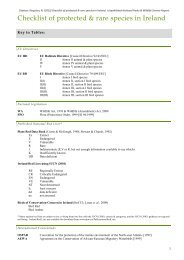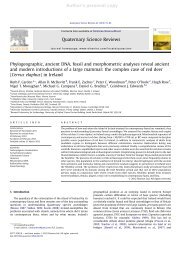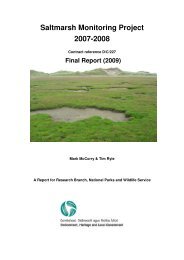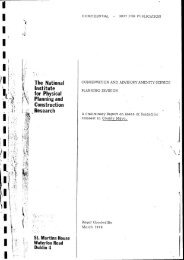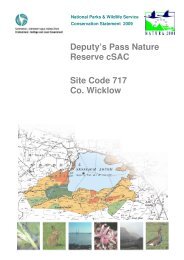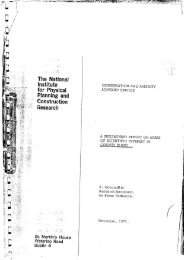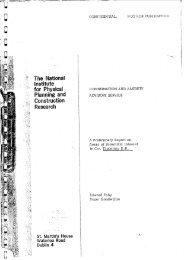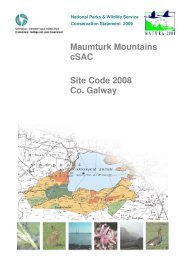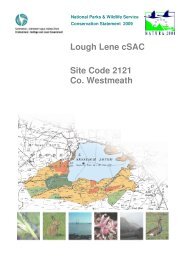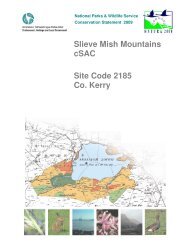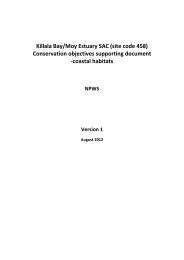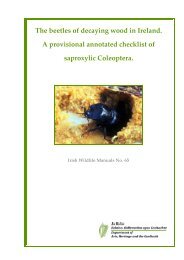The Role of Kelp in the Marine Environment - National Parks ...
The Role of Kelp in the Marine Environment - National Parks ...
The Role of Kelp in the Marine Environment - National Parks ...
You also want an ePaper? Increase the reach of your titles
YUMPU automatically turns print PDFs into web optimized ePapers that Google loves.
Jorgensen and Christie, 2003; Christie et al., 2003). Mobile macr<strong>of</strong>auna (particularly<br />
crustaceans and molluscs) are important <strong>in</strong> <strong>the</strong> diet <strong>of</strong> many fishes and <strong>the</strong>ir<br />
abundance <strong>in</strong> <strong>the</strong> kelp forest makes this habitat a rich source <strong>of</strong> prey for many top<br />
down predatory consumers (Jorgensen and Christie, 2003; Christie et al., 2003).<br />
Christie et al. (op. cit.) estimated that an average density exceed<strong>in</strong>g 100,000 mobile<br />
macr<strong>of</strong>auna <strong>in</strong>dividuals per m 2 could be expected <strong>in</strong> a Norwegian L. hyperborea kelp<br />
forest.<br />
Variation <strong>in</strong> abundance <strong>of</strong> prey taxa and faunal groups may be reflected <strong>in</strong> <strong>the</strong> diet <strong>of</strong><br />
some kelp fish species. For example, amphipods and gastropods were found to be <strong>the</strong><br />
dom<strong>in</strong>ant faunal groups <strong>in</strong> studies <strong>of</strong> recover<strong>in</strong>g and natural kelp forests <strong>in</strong> Norway<br />
(Moore, 1972; 1973; Schultze et al., 1990; Christie et al., 1998; 2003; Norderhaug et<br />
al., 2002). Correspond<strong>in</strong>gly, <strong>the</strong>se groups have been found to be dom<strong>in</strong>ant <strong>in</strong> <strong>the</strong> diet<br />
<strong>of</strong> various fish species associated with kelp habitat (Gordon, 1983; Fossa, 1995; Fossa<br />
et al., 1998; Fredriksen, 2003). O<strong>the</strong>r studies have noted opportunistic tendencies <strong>in</strong><br />
wrasse species with respect to variation <strong>in</strong> prey availability, with seasonal and<br />
temporal changes <strong>in</strong> <strong>the</strong> abundance <strong>of</strong> prey species reflected <strong>in</strong> <strong>the</strong> diet (Deady, 1995;<br />
Deady and Fives, 1995ab; Varian, 1998; Zemke-White and Clements, 2004).<br />
<strong>The</strong>re may also be some <strong>in</strong>terspecific variation between kelp species <strong>in</strong> <strong>the</strong> forag<strong>in</strong>g<br />
opportunities available to fishes. Accord<strong>in</strong>g to Schultze et al. (1990), <strong>the</strong> diversity<br />
and abundance <strong>of</strong> macro<strong>in</strong>vertebrates is higher <strong>in</strong> Lam<strong>in</strong>aria hyperborea beds than <strong>in</strong><br />
L. digitata stands. Invertebrate abundance has also been related to <strong>the</strong> age and size <strong>of</strong><br />
<strong>the</strong> plant with<strong>in</strong> kelp species. For example, R<strong>in</strong>de et al. (1992) found that <strong>the</strong> number<br />
<strong>of</strong> <strong>in</strong>dividuals and species <strong>of</strong> kelp-associated flora and fauna <strong>in</strong>creased significantly<br />
with <strong>in</strong>creas<strong>in</strong>g age <strong>of</strong> kelp plants. Thus, <strong>the</strong> availability <strong>of</strong> macro<strong>in</strong>vertebrates as<br />
food items for kelp fishes may depend to an extent on <strong>the</strong> species and age <strong>of</strong> kelp<br />
plants distributed with<strong>in</strong> <strong>the</strong> kelp habitat.<br />
Some Norwegian studies have considered <strong>the</strong> importance <strong>of</strong> fish <strong>in</strong> <strong>the</strong> trophic<br />
structure <strong>of</strong> <strong>the</strong> kelp forest ecosystem, i.e., as prey for seabirds and o<strong>the</strong>r fish (Røv et<br />
al., 1990; Lorentsen et al., 2004) and as top down predators and consumers <strong>of</strong><br />
<strong>in</strong>vertebrate fauna (Nelson, 1979; Kennelly, 1983, 1991; Holmlund et al., 1990;<br />
Nordeide and Fossa, 1992; Fosne and Gjosaeter, 1996; Fredriksen, 2003). Røv et al.<br />
32



